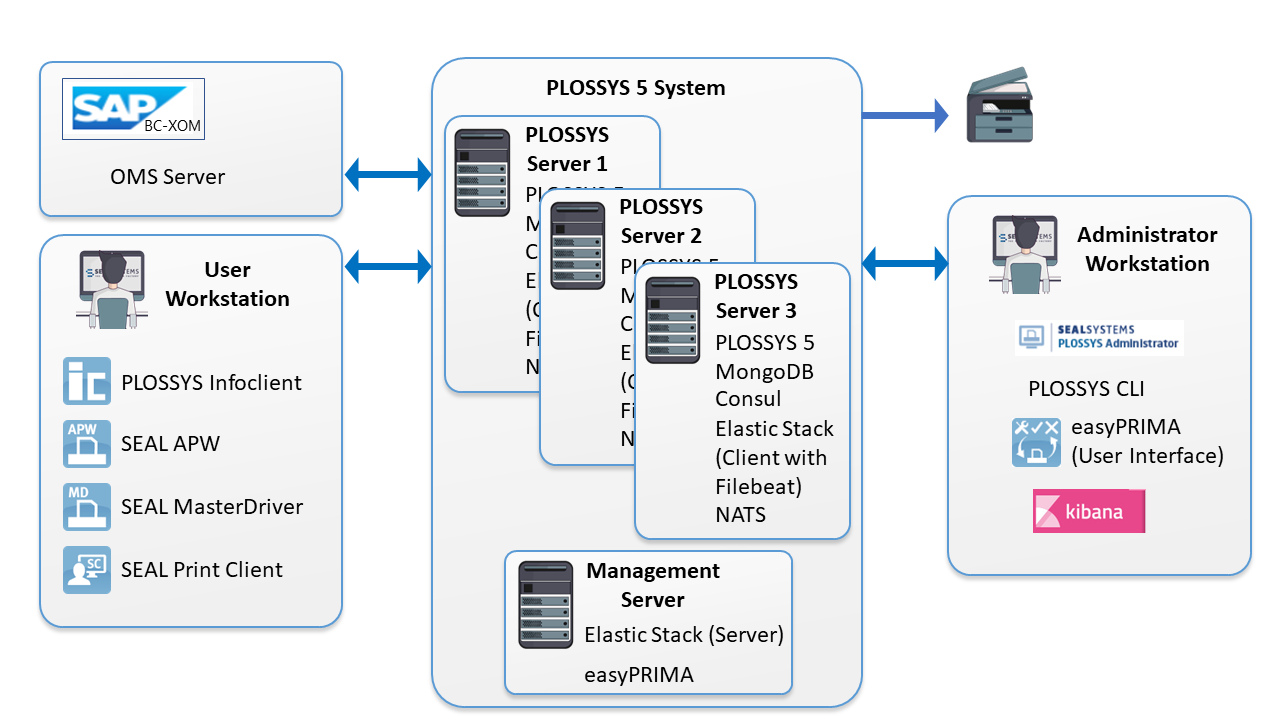Overview¶
A cluster consists of at least three PLOSSYS 5 servers and one management server. The number of PLOSSYS 5 servers has to be odd. The following instructions refer to a cluster containing three PLOSSYS 5 servers.

Requirement¶
All PLOSSYS 5 servers to be connected as a cluster have to be installed identically. For more information about the installation and configuration of a PLOSSYS 5 server, refer to the installation and the configuration of the PLOSSYS 5 server.
Hint - time synchronization
Make sure that the times are synchronous among all PLOSSYS 5 servers in a cluster. Otherwise, the jobs' log data will not be displayed in the correct order.
Scenarios¶
When configuring a cluster, it is important on which PLOSSYS 5 server the instruction is carried out. Below, the PLOSSYS 5 systems are named <server_1>, <server_2> and <server_3>. The mapping of the servers has to be maintained during the complete configuration of the cluster. The following scenarios are distinguished:
-
Scenario: Combining three newly installed PLOSSYS 5 servers to a cluster
In this case, the names can be mapped to the servers arbitrarily.
-
Scenario: Expanding a PLOSSYS 5 single server to a cluster
If a PLOSSYS 5 server has already been running and this is to be expanded to a cluster, the mapping is important:
-
The already existent PLOSSYS 5 server is named
<server_1>. -
The two new PLOSSYS 5 servers are named
<server_2>and<server_3>. Here, the names can be mapped arbitrarily.
-
Configure the Cluster¶
In order to run PLOSSYS 5 systems as a cluster, the following parts of the PLOSSYS 5 installation have to be adjusted:
-
Logging
All PLOSSYS 5 servers in a cluster have to transfer their log data to the same Elasticsearch server. For how to configure the logging in a cluster, refer to the SEAL Elastic Stack documentation.
-
Consul
The Consul processes of all PLOSSYS 5 servers in a cluster have to be connected for cross-server service discovery and system configuration. For how to configure the Consul processes in a cluster, refer to Configure Consul in a Cluster.
-
Housekeeping
In order to avoid unnecessary load on MongoDB during housekeeping process done by the
seal-housekeeperservice, configure the HOUSEKEEPER_ELECTION_TIMEOUT service key. -
SEAL NATS
For the SEAL NATS message broker, configure the clustering, refer to the SEAL NATS documentation. In PLOSSYS 5, configure the BROKER_SERVERS service key.
Secure the Cluster¶
For information about how to secure the installation in cluster mode, refer to the following chapters:
For how to secure Filebeat, refer to the SEAL Elastic Stack documentation.
For how to secure MongoDB, refer to the SEAL-specific MongoDB documentation.
Next Step¶
Continue with: Configure Consul in a Cluster